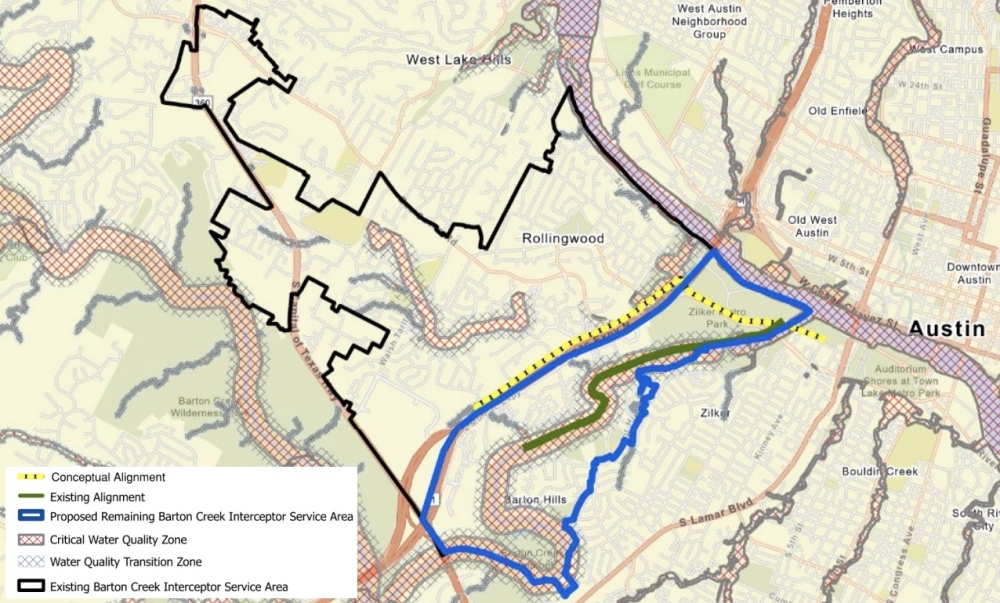The setup
Earlier this year, City Council asked to evaluate getting rid of the Barton Creek Interceptor that runs along the creek south of Lady Bird Lake. The 11,000-foot pipe was built in the 1960s and serves hundreds of properties in the area.

Officials in Rollingwood and West Lake Hills, which also rely on Austin's infrastructure for their wastewater needs, have said the line could constrain plans for growth in their jurisdictions as well.
Another detail
The creek and pipeline are situated in areas regulated under the Save Our Springs Ordinance. Approved by voters in 1992, it laid out limits on new development in environmentally sensitive areas, such as the Critical Water Quality Zone, or CWQZ, covering land on both sides of the creek.
What's happening
Austin Water released its report on the Barton Creek line and future wastewater needs in November.
Utility staff said the existing pipeline appears to be in "very good" condition and that Barton Creek consistently scores well in city water quality testing. Despite its overall age, they also noted the line hasn't suffered serious maintenance issues aside from a 50-gallon spill in 2015 caused by a blockage.
The review accounted for likely updates in the area, such as:
- The possible redevelopment of the Barton Creek Square mall property
- Commercial additions in Rollingwood and West Lake Hills
- Residential and office projects planned east and west of MoPac
That would involve building a new wastewater line through Zilker Metropolitan Park and along the highway to serve projected development that's expected to mostly take place west of the highway.

Zooming in
Charles Celauro, AW's assistant director of engineering services, told council Nov. 12 that the utility arrived at the recommendation in part given the landscape along Barton Creek.
The waterway and current interceptor sit at the "bottom of the valley" between neighborhoods to the east and west, he said. If the current pipeline were taken out, a replacement would require far more intensive infrastructure, such as new water pumping stations, to serve the surrounding homes and properties.
“Since most of the development is up to Barton Creek, most lift stations would be in the [CWQZ] and 100-year floodplain," Celauro said. "Additionally, if we did decide to relocate the Barton Creek Interceptor to the east, additional crossings to have the services from the west to go to the east would need to be done as well."

According to council
While continuing to review the MoPac proposal, Ellis said she's still determined to see the Barton Creek pipe removed. The infrastructure already isn't meeting community wastewater needs, she said, and pulling the line out of the creek could save the water and ecosystem from the "significant harm" of a possible leak.
"We have technology and systems capable of alerting Austin Water of critical leaks or malfunctions, which our current underwater pipe system cannot provide. As it stands today, we would not know there was a problem until it was too late," she said in a statement. "That’s a big risk I’m not willing to take, and doing nothing is not an option. Also, current residences west of MoPac are chopping down healthy trees because they are required to allow space for septic fields. This is not the ideal option for these residents or the environment."
Council member Alison Alter, who represents much of West Austin, said the city should tread lightly around Barton Creek given the extra protections in place there. She also said opening a new wastewater line could unintentionally accelerate more development in the Save Our Springs Ordinance area.
Mayor Pro Tem Leslie Pool shared a different vision, stating that redevelopment under modern rules and strategies could end up restoring some natural features in Southwest Austin. For example, she said a forest on the Barton Creek Square property was destroyed years ago to clear the way for the mall and its sprawling parking lot. If tearing up that concrete and restoring some trees were possible with a new pipeline, she said she'd cheer the process on.
City leaders have yet to decide on any next steps for wastewater service changes along the creek. If new projects are officially considered, AW would continue tracking water use in the area and launch early engineering work for the new lines to prepare. The utility is also asking for water reuse systems to be worked into new projects and redevelopments in line with city conservation strategies.





